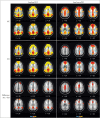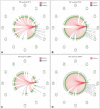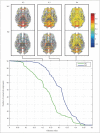Alteration in the Local and Global Functional Connectivity of Resting State Networks in Parkinson's Disease
- PMID: 29381889
- PMCID: PMC5790628
- DOI: 10.14802/jmd.17061
Alteration in the Local and Global Functional Connectivity of Resting State Networks in Parkinson's Disease
Abstract
Objective: Parkinson's disease (PD) is a neurodegenerative disorder that mainly leads to the impairment of patients' motor function, as well as of cognition, as it progresses. This study tried to investigate the impact of PD on the resting state functional connectivity of the default mode network (DMN), as well as of the entire brain.
Methods: Sixty patients with PD were included and compared to 60 matched normal control (NC) subjects. For the local connectivity analysis, the resting state fMRI data were analyzed by seed-based correlation analyses, and then a novel persistent homology analysis was implemented to examine the connectivity from a global perspective.
Results: The functional connectivity of the DMN was decreased in the PD group compared to the NC, with a stronger difference in the medial prefrontal cortex. Moreover, the results of the persistent homology analysis indicated that the PD group had a more locally connected and less globally connected network compared to the NC.
Conclusion: Our findings suggest that the DMN is altered in PD, and persistent homology analysis, as a useful measure of the topological characteristics of the networks from a broader perspective, was able to identify changes in the large-scale functional organization of the patients' brain.
Keywords: Parkinson’s disease; default mode network; functional connectivity; persistent homology; resting state fMRI.
Conflict of interest statement
The authors have no financial conflicts of interest.
Figures




Similar articles
-
Dysfunction of the Default Mode Network in Drug-Naïve Parkinson's Disease with Mild Cognitive Impairments: A Resting-State fMRI Study.Front Aging Neurosci. 2016 Oct 26;8:247. doi: 10.3389/fnagi.2016.00247. eCollection 2016. Front Aging Neurosci. 2016. PMID: 27833548 Free PMC article.
-
Connectivity Between Brain Networks Dynamically Reflects Cognitive Status of Parkinson's Disease: A Longitudinal Study.J Alzheimers Dis. 2019;67(3):971-984. doi: 10.3233/JAD-180834. J Alzheimers Dis. 2019. PMID: 30776007 Free PMC article.
-
Functional connectivity within the default mode network is associated with saccadic accuracy in Parkinson's disease: a resting-state FMRI and videooculographic study.Brain Connect. 2013;3(3):265-72. doi: 10.1089/brain.2013.0146. Brain Connect. 2013. PMID: 23627641
-
Resting-state fMRI in Parkinson's disease patients with cognitive impairment: A meta-analysis.Parkinsonism Relat Disord. 2019 May;62:16-27. doi: 10.1016/j.parkreldis.2018.12.016. Epub 2018 Dec 17. Parkinsonism Relat Disord. 2019. PMID: 30580907 Review.
-
Alterations in Large-Scale Intrinsic Connectivity Networks in the Parkinson's Disease-Associated Cognitive Impairment Continuum: A Systematic Review.Noro Psikiyatr Ars. 2022 Nov 7;59(Suppl 1):S57-S66. doi: 10.29399/npa.28209. eCollection 2022. Noro Psikiyatr Ars. 2022. PMID: 36578982 Free PMC article. Review.
Cited by
-
Modulations of static and dynamic functional connectivity among brain networks by electroacupuncture in post-stroke aphasia.Front Neurol. 2022 Dec 1;13:956931. doi: 10.3389/fneur.2022.956931. eCollection 2022. Front Neurol. 2022. PMID: 36530615 Free PMC article.
-
Altered Long- and Short-Range Functional Connectivity Density in Patients With Thyroid-Associated Ophthalmopathy: A Resting-State fMRI Study.Front Neurol. 2022 Jun 23;13:902912. doi: 10.3389/fneur.2022.902912. eCollection 2022. Front Neurol. 2022. PMID: 35812093 Free PMC article.
-
Characterizing resting-state networks in Parkinson's disease: A multi-aspect functional connectivity study.Brain Behav. 2021 May;11(5):e02101. doi: 10.1002/brb3.2101. Epub 2021 Mar 30. Brain Behav. 2021. PMID: 33784022 Free PMC article.
-
The role of the medial prefrontal cortex in cognition, ageing and dementia.Brain Commun. 2021 Jun 11;3(3):fcab125. doi: 10.1093/braincomms/fcab125. eCollection 2021 Jul. Brain Commun. 2021. PMID: 34222873 Free PMC article. Review.
-
Topological disruption of high-order functional networks in cognitively preserved Parkinson's disease.CNS Neurosci Ther. 2023 Feb;29(2):566-576. doi: 10.1111/cns.14037. Epub 2022 Dec 5. CNS Neurosci Ther. 2023. PMID: 36468414 Free PMC article.
References
-
- Kalia LV, Lang AE. Parkinson’s disease. Lancet. 2015;386:896–912. - PubMed
-
- Rosazza C, Minati L. Resting-state brain networks: literature review and clinical applications. Neurol Sci. 2011;32:773–785. - PubMed
-
- Biswal BB, Van Kylen J, Hyde JS. Simultaneous assessment of flow and BOLD signals in resting-state functional connectivity maps. NMR Biomed. 1997;10:165–170. - PubMed
LinkOut - more resources
Full Text Sources
Other Literature Sources

